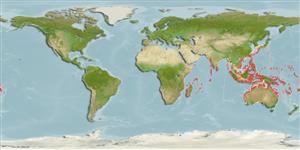Actinopterygii (peixes com raios nas barbatanas) >
Pleuronectiformes (Flatfishes) >
Bothidae (Lefteye flounders)
Etymology: Asterorhombus: Greek, aster = star + Greek, rhombos = paralelogram (Ref. 45335); cocosensis: Named for its type locality, Cocos Island (Ref. 57759).
Ambiente / Clima / Intervalo
Ecologia
; marinhas demersal; intervalo de profundidade 1 - 30 m (Ref. 57759). Tropical, preferred ?
Indo-West Pacific: Mozambique to Fiji; north to Japan, south to Queensland, Australia (not occurring nonmarginally on the Pacific Plate).
Tamanho / Peso / Idade
Maturity: Lm ? range ? - ? cm
Max length : 12.0 cm SL macho/indeterminado; (Ref. 57759)
Raios dorsais moles (total): 79-83; Raios anais moles: 59 - 64; Vértebras: 35 - 36. This species is characterized by the following: body depth 51.5-58.3; sexual dimorphism
in interorbital width, in specimens approximately 6.0 cm SL, males 4.1-7.9, females 3.2-5.0; first dorsal-fin ray isometric relative to SL, with distinct membranous structure confined to tip. Pectoral fin count at the ocular side 10-13, blind side 8-11. The membranous structure at the tip of the first dorsal fin resembles a small fish or crustacean (possibly a small hippolytid shrimp), authors called the ray the illicium and the structure at the tip as the esca (Ref. 57759).
Found on pale sandy substrates in clearwater coastal bays to outer reef lagoons and sandy gutters on reef flats. Often crawls over low stony reef (Ref. 48637). The membranous structure at the tip of the first dorsal fin resembles a small fish or crustacean (possibly a small hippolytid shrimp), authors called the ray the illicium and the structure at the tip as the esca. The illicium waves the esca back and forth near mouth to attract prey. Shows sexual dimorphism in width of the interorbital origin, wider in males than females. Most frequently collected by divers.
Life cycle and mating behavior
Maturidade | Reprodução | Desova | Ovos | Fecundidade | Larvas
Hensley, D.A., 2005. Revision of the genus Asterorhombus (Pleuronectiformes: Bothidae). Copeia 2005(3):445-460. (Ref. 57759)
Categoria na Lista Vermelha da IUCN (Ref. 115185)
CITES (Ref. 94142)
Not Evaluated
Ameaça para o homem
Harmless
Utilização humana
Mais informação
Nomes comunsSinónimosMetabolismoPredadoresEcotoxicologiaReproduçãoMaturidadeDesovaFecundidadeOvosDesenvolvimento dos ovos
ReferênciasAquaculturaPerfil para aquaculturaEstirpesGenéticaFrequência dos alelosHereditariedadeDoençasProcessamentoMass conversion
ColaboradoresFotografiasStamps, CoinsSonsCiguateraVelocidadeTipo de nataçãoÁrea branquialOutras referênciasCérebrosVisão
Ferramentas
Relatórios especiais
Descarregue XML
Fontes da internet
